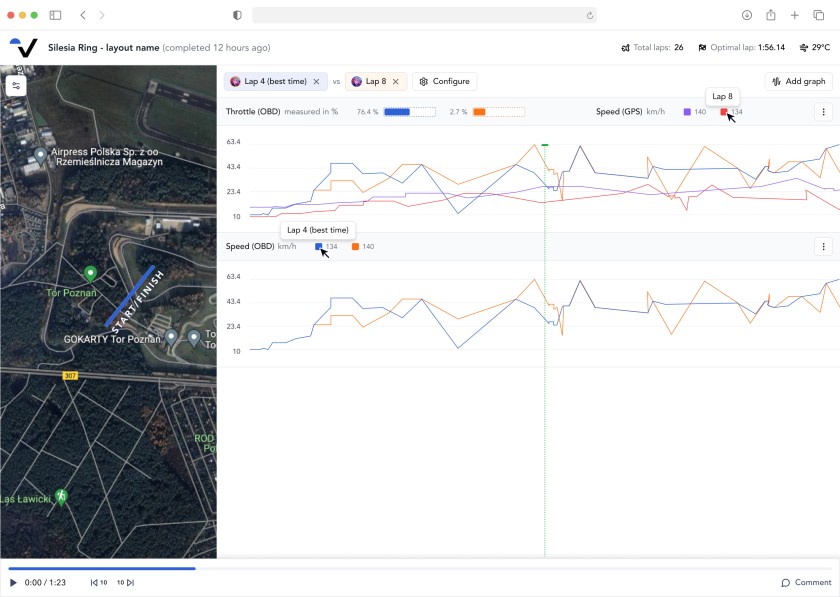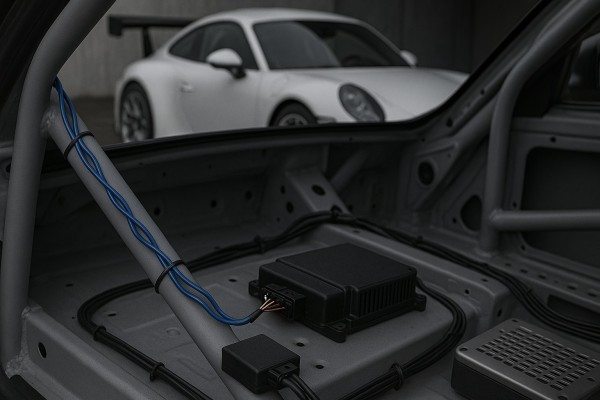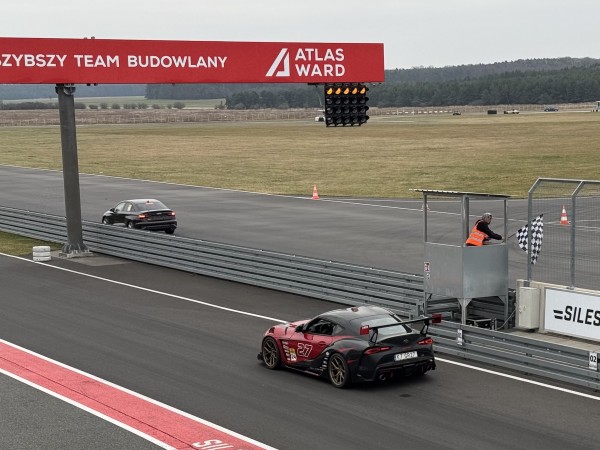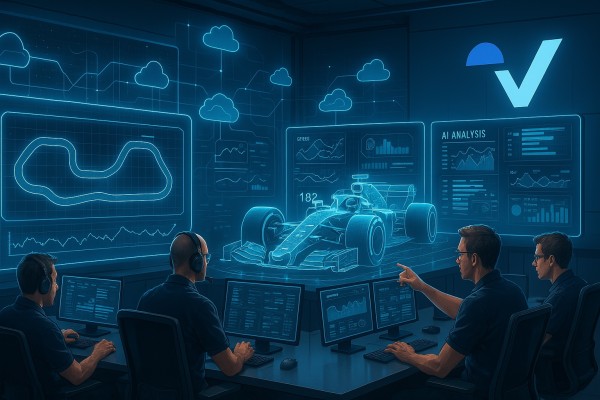Racing telemetry
Enhancing Insights with Telemetry Overlays: A New Perspective on Racing Data
by Paweł Sobociński |

In the fast-paced world of motorsport, data is king. The ability to collect, analyze, and interpret information about a car’s performance and a driver’s techniques can be the difference between winning and losing. One of the most innovative tools to emerge in recent years is the telemetry overlay. By visualizing critical data directly on video footage, telemetry overlays provide a unique and impactful way to understand racing performance.
This article delves into the concept of telemetry overlays, their components, benefits, and how they are transforming motorsport analysis.
What is a Telemetry Overlay?

A telemetry overlay is a graphical representation of performance data displayed on video footage, typically recorded during a race or a practice session. These overlays integrate numerical and visual data to provide real-time or post-session insights, allowing racers and analysts to correlate actions on the track with corresponding metrics.
Key elements of a telemetry overlay often include:
- Speedometers: Indicating the car’s speed at any given moment.
- G-force Meters: Displaying lateral and longitudinal forces during acceleration, braking, and cornering.
- Throttle and Brake Indicators: Visualizing the driver’s inputs on the throttle and brake pedals.
- Steering Angles: Showing the degree of steering input relative to the car’s trajectory.
- Lap Times and Sector Splits: Providing context for performance during specific sections of the track.
- Track Maps with GPS Positioning: Highlighting the car’s position and movement in real time.
These elements combine to create a comprehensive picture of both vehicle performance and driver behavior, making telemetry overlays a powerful tool for analysis.
How Telemetry Overlays Work
Telemetry overlays are created by synchronizing video footage with data collected from sensors and telemetry systems. Here’s a step-by-step look at how they work:
1. Data Collection
Data is gathered from various sources during a session. These include:
- Vehicle Sensors: Such as GPS modules, accelerometers, gyroscopes, and OBD (On-Board Diagnostics) systems.
- External Devices: High-precision tools like Bluetooth-enabled data loggers or racing-specific hardware.
- Video Recording Equipment: Cameras mounted on the car to capture footage from the driver’s perspective or an external angle.
2. Data Processing
The collected telemetry data is carefully processed and formatted to align seamlessly with video timelines, ensuring accuracy and consistency. This involves converting raw data into a usable format and matching it to the exact timestamps of the video footage. Specialized software plays a crucial role in this process, not only synchronizing the data but also enabling customizable overlays that enhance the visual representation. These overlays can include speed, location, or other metrics, providing a more dynamic and insightful viewing experience.
3. Overlay Creation
The processed data is then visualized directly on the video, providing a clear and interactive way to analyze performance. Modern tools offer users the flexibility to select specific metrics for display, such as speed, distance, or time, allowing for a customized analysis based on individual needs. Users can also adjust graphical styles to better suit their preferences, such as changing colors, graph types, or layouts, and highlight particular aspects of performance for deeper insights.
4. Review and Analysis
Once the overlay is complete, drivers, coaches, and engineers can carefully review the video to gain valuable insights. This process helps them identify key strengths, pinpoint weaknesses, and highlight specific areas for improvement. By analyzing the footage in detail, they can develop strategies to enhance performance, refine techniques, and optimize overall results.
Benefits of Telemetry Overlays
Telemetry overlays offer numerous advantages for racers and teams. Here are some key benefits:
1. Enhanced Visualization
Raw data can be overwhelming and difficult to interpret. Telemetry overlays transform complex information into an easily digestible visual format. Seeing speed, throttle inputs, and steering angles directly on video provides intuitive insights.
2. Correlation of Data and Action
One of the most powerful aspects of telemetry overlays is the ability to correlate a driver’s actions with corresponding metrics. For example, you can observe how a late braking maneuver impacts entry speed and cornering efficiency.
3. Improved Driver Feedback
Coaches can use overlays to provide targeted feedback. By pointing out specific instances where the driver could improve, such as underutilizing throttle during corner exits, telemetry overlays make coaching more effective.
4. Better Understanding of Vehicle Dynamics
Overlays help teams understand how a car behaves under different conditions. For instance, analyzing G-force data during high-speed corners can highlight the need for adjustments to suspension settings or tire pressures.
5. Objective Performance Analysis
Unlike subjective feedback, telemetry overlays provide objective data. This eliminates guesswork and ensures that decisions are based on facts rather than impressions.
6. Increased Engagement for Viewers
Telemetry overlays are not only useful for racers but also enhance the viewing experience for fans and sponsors. By adding dynamic data visuals to race footage, audiences gain a deeper appreciation of the skill and precision involved in motorsport.
Applications of Telemetry Overlays
Telemetry overlays are versatile and find use in various contexts within motorsport:
1. Driver Training and Development
For aspiring racers, telemetry overlays serve as an invaluable learning tool. By reviewing their actions and performance metrics, drivers can refine their techniques and improve consistency.
2. Team Strategy and Engineering
Professional racing teams use telemetry overlays to fine-tune car setups and devise strategies. For example, analyzing overlays might reveal that a driver is losing time due to understeer in specific corners, prompting adjustments to the car’s alignment or tire choices.
3. Sim Racing
In the world of eSports, telemetry overlays are becoming increasingly popular. Sim racers use them to analyze their virtual driving performance, replicating the analytical approach of real-world motorsport.
4. Event Broadcasting
Television and online broadcasts of racing events often include telemetry overlays to enhance storytelling. Viewers can see real-time speed, G-forces, and other data, making races more engaging and educational.
5. Content Creation for Enthusiasts
Motorsport content creators use telemetry overlays to produce compelling videos. Whether it’s a breakdown of a lap record or a comparison of different cars, overlays add depth and professionalism to their content.
Tips for Effective Telemetry Overlays
To get the most out of telemetry overlays, follow these tips:
- Select Relevant Metrics - Avoid cluttering the video with too much information. Focus on key metrics that provide actionable insights.
- Ensure Accurate Synchronization - Precise alignment of data with video footage is crucial. Use software with robust synchronization features to avoid discrepancies.
- Customize for Clarity - Adjust the size, color, and placement of overlay elements to ensure readability without obstructing important parts of the video.
- Combine with Other Analysis Tools - Telemetry overlays are most effective when used alongside other analysis tools, such as detailed lap time comparisons or driver input charts.
- Review Regularly -Frequent review sessions using telemetry overlays help drivers and teams stay on top of performance trends and identify areas for continuous improvement.
The Future of Telemetry Overlays
As technology advances, telemetry overlays are expected to become even more sophisticated. Emerging trends include:
- Real-Time AR Overlays: Augmented reality systems that display telemetry data in real time on a driver’s helmet visor or heads-up display (HUD).
- AI-Powered Insights: Machine learning algorithms that analyze telemetry data and provide automated recommendations for improvement.
- Interactive Overlays: Tools that allow viewers to interact with telemetry data during race broadcasts, creating a more immersive experience.
Conclusion
Telemetry overlays are revolutionizing the way data is analyzed and presented in motorsport. By bridging the gap between numbers and actions, they empower racers to optimize their performance, engineers to fine-tune setups, and fans to engage more deeply with the sport.
Whether you’re a professional racer, a weekend enthusiast, or a content creator, telemetry overlays offer a unique perspective on racing data. With the right tools and approach, they can unlock new levels of insight and performance, making every lap a step closer to perfection.




